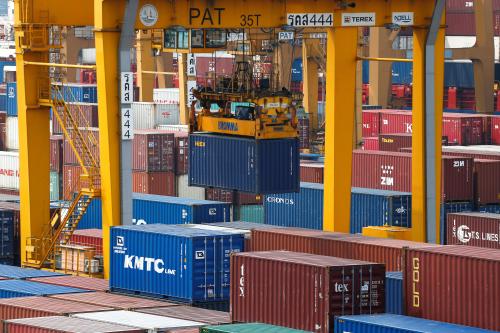Digital technology has enormous potential to accelerate international trade, a major driver of economic growth. The internet has greatly expanded firms’ potentials to produce new goods and services and serve new markets. In particular, the internet is dramatically impacting retail, financial, and professional services sectors. Firms in these sectors can create new digital products, such as music, videos, and books, and digitize and deliver their services over long distances. To keep up with this remarkable growth, the European Commission’s Digital Single Market agenda has prioritized digital trade.
However, Europe is still lagging behind. While the internet is facilitating the increase in trade in services globally, Europe and Central Asia (ECA) is not keeping up. In Western Europe, the exports of information and communication technology (ICT) services average 4.4 percent of GDP, but only 0.8 percent in other parts of ECA. The exports of ICT services are even lower in Russia, Turkey, South Caucasus, and Central Asia, where exports of ICT services average below 0.3 percent of GDP in all countries except Armenia (1.1 percent) and Tajikistan (1.3 percent).
While these statistics are striking, they do not provide a complete picture of ICT services exports. Services are difficult to measure, as they are intangible and leave little administrative trail when crossing borders. Services delivered through the internet are particularly difficult to capture as discussed in technical note by UNCTAD (2015). In addition, official statistics do not record free services provided on the internet. For example, services in the form of e-mail, video, search services, and social media websites are usually provided free and paid for through advertising revenues, making it difficult to assess their economic value.
An alternative measure of a country’s service exports is the amount of internet communication each receives. Many offices make calls using a broadband internet connection—or Voice over Internet Protocol (VoIP)—to their foreign subsidiaries, suppliers, and partners to provide instructions, to request technical assistance, or to seek professional and legal advice. The internet voice traffic entering a country can be an indication of the amount of business and professional services that a country exports. However, the VoIP data may not be a perfect indication of ICT services export because the data are not separated into business and personal calls and are based on surveys from national regulators. But it is a good proxy of digital service exports and provides a comprehensive source of bilateral voice traffic among many countries.
The ECA region has 20 percent of the global voice traffic, behind the East Asia and Pacific region with 28 percent and Latin America and the Caribbean with 24 percent (Figure 1). In 2014, 78 percent of voice traffic in ECA was within the region, compared with almost 50 percent of voice traffic in the East Asia and Pacific region. This suggests that ECA countries are not taking advantage of digital technologies to market and export more services to international markets, especially to the large North American market, which accounts for only 13 percent of ECA’s VoIP traffic.
Figure 1: ECA has a sizeable amount of incoming voice traffic, but most is from other ECA countries
 Source: Calculations based on voice traffic data from Telegeography.
Source: Calculations based on voice traffic data from Telegeography.
Note: The incoming flows for each region are calculated by aggregating the amount of VoIP calls for the latest available year (either 2013 or 2014) entering each country in that region. The size of the ribbons represents the amount of flows between the regions, measured in millions of minutes. The flows for the Europe and Central Asia region are shaded blue and the flows for the East Asia and Pacific region are shaded red. For example, the blue ribbon with the yellow arrow represents the flows from the Europe and Central Asia region to itself. Regions are geographical classifications that include developed and developing countries.
European countries can take two policy actions to increase their digital trade in services. First, countries can lower entry barriers into services sectors, such as retail, professional, and transport services. Market entrants tend to bring new technology or business models that allow them to offer better quality and cheaper services, making them attractive to foreign customers. The entrants can also create a competitive business environment that motivates incumbent firms to become more productive and sell beyond the domestic market. Second, countries should focus on reducing the trade barriers that their firms face in importing countries. Some countries have denied access to certain services sectors, even after committing to the World Trade Organization General Agreement on Trade in Services. There were also cases where EU countries tried to ban the online sale of services from other EU countries. Reducing these barriers will depend on a country’s bargaining power and the trade partner’s interests.
While some countries are able to address these issues bilaterally, many ECA countries should approach the issues at the international level at the WTO or regional level at the European Union.
As digital technology improves, digital trade will become a larger portion of international trade. ECA countries can increase their digital trade in goods and services to find new drivers of economic growth.
For more on how the internet is affecting Europe and Central Asia see:
The Brookings Institution is committed to quality, independence, and impact.
We are supported by a diverse array of funders. In line with our values and policies, each Brookings publication represents the sole views of its author(s).








Commentary
Europe is falling behind in digital trade—Time to take action
April 17, 2017